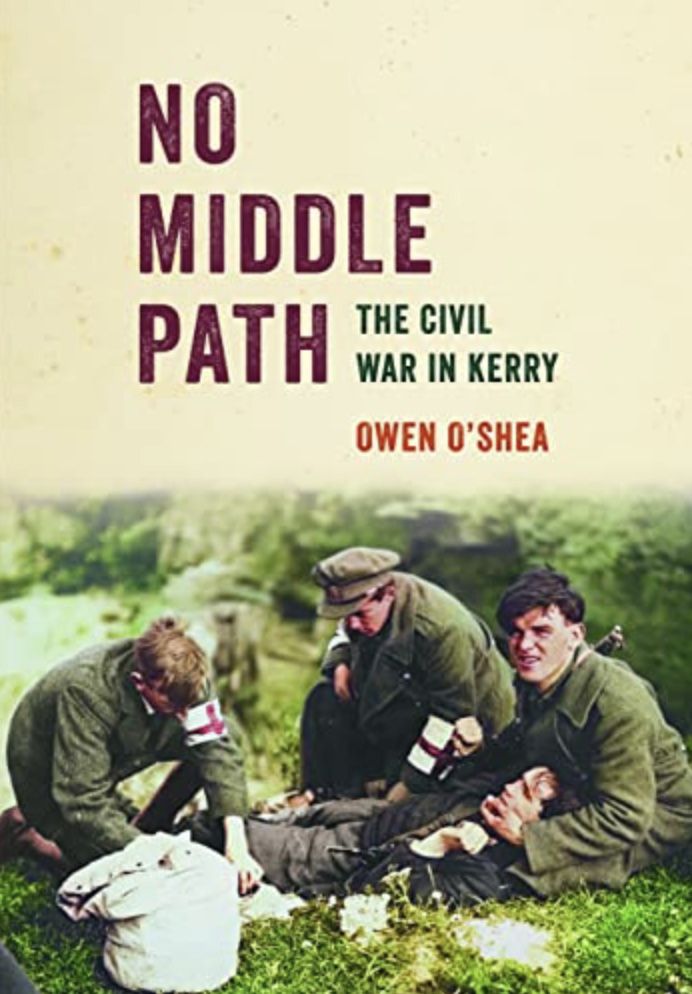No Middle Path – The Civil War in Kerry by Owen O’Shea (Merrion Press)
IN no part of Ireland was the Civil War more vicious and bitter than in County Kerry.
One hundred years ago this month both the National Army and the anti-Treaty IRA were engaged in a campaign of total war, the brutality of which emphasised the visceral divisions of the split that followed the signing of the Anglo-Irish Treaty of 1921.
No Middle Path – The Civil War in Kerry by Owen O’Shea gives an insight into the cause of that split in one particular county, and the atrocities that occurred in its aftermath and offers an explanation into why old scars take a long time to heal, if they heal at all.
This well-researched book is also well-written, in that it doesn’t get bogged down in unnecessary detail. Having said that it makes for uncomfortable reading at times as the brutality meted out from both sides can shock even this reviewer who remembers well our most recent conflict and how we are still living today with its legacy and consequences.
Of course what makes the brutality of this fratricide all the more poignant is the knowledge that most of those involved in military action on both sides were once comrades in arms in the cause against the British. The young age of those who perished also adds to the sadness that hangs over these pages.
With campaigning across the country in the wake of Collins’ return from London, the vast majority of the IRA in Kerry came out against the Treaty, although there were divisions within IRA companies within the county. O’Shea argues that the IRA split in Kerry had much to do with internal power struggles and “hostility towards headquarters in Dublin as it had with the terms of the Anglo-Irish Treaty”. I would have liked to have heard more about the pros and cons of the Treaty debate from those on the ground. Uncomfortable as it is, partition of the country doesn’t appear to be at the forefront of most people’s concerns. While the oath of allegiance was an anathema to those opposed to the Treaty; having their own army and control over the economy and education was a big draw for the Treaty’s backers. And so Kerry’s Sinn Féin TDs split down the middle over the issue, while the country voted in favour.
By 2nd August to the beginning of December 1922, 79 anti-Treaty IRA had been killed; 119 wounded; and 704 taken prisoner. On the National Army side 52 were dead; 117 wounded, with seven deserters.
Matters weren’t helped by De Valera’s declaration in Killarney that republicans would have to ‘march over the dead bodies of their brothers’ and ‘wade through Irish blood’. Tensions were mounting in the county as the Treaty was debated and by the start of the summer 1922 the Four Courts in Dublin was being bombarded by the new government.
The brutality that would accompany government forces in Kerry can be led at the door of Paddy O’Daly, a Dubliner, and a member of ‘The Squad’ – Michael Collins’ intelligence until during the Tan War. The National Army had landed by sea at Fenit, near Tralee, taking the republican forces by surprise. Within days the Irregulars were on the run from most urban areas and a guerrilla campaign would be played out over the next year – from major military engagements to hit-and-run tactics, to ambush and assassination.
Atrocities were common place. In Kenmare Brigadier General Tom O’Connor Scarteen and his brother Captain John O’Connor Scarteen, who were both members of the Free State Army, were shot dead in the family home with Tom pleading: “For God’s sake, don’t shoot an unarmed man.” Bertie Murphy, a member of Fianna Éireann, was killed at the hands of Colonel David Neligan at the Free State Army headquarters in the improvised barracks at the great Southern Hotel, Killarney, when he was thrown down a coal chute after being “mercilessly beaten”. At times personal enmity crossed over into the political field with fatal consequences. Republican John Kevins was badly wounded and while in army custody was bayoneted to death.
Government emergency legislation meant that anyone caught with a firearm faced execution.
At the same time lawlessness reigned in Kerry. With no justice system to be had, armed men settled old disputes. With the IRA taking to the hills, they had a problem of supplying food to volunteers. Shops belonging to unsympathetic shopkeepers were constantly robbed to feed hungry men.
By 2nd August to the beginning of December 1922, 79 anti-Treaty IRA had been killed; 119 wounded; and 704 taken prisoner. On the National Army side 52 were dead; 117 wounded, with seven deserters.
And it was to get worse.
A series of events in March 1923 led to one of the most notorious events of the war. It occurred after five members of the Free State Army were killed as a landmine exploded near Knocknagoshel. In retaliation nine IRA prisoners were rounded up and taken to Ballyseedy and tied together around a mine which was then detonated. Eight were blown to pieces but miraculously Stephen Fuller was blown unconscious into a nearby river and survived.
Fuller later recalled: “One of our lads asked to be left say his prayers. He said, ‘No prayers.’ He said, ‘Our fellas didn’t get any time for prayers,’ and he said, ‘Maybe some of ye might go to Heaven… ye might meet our fellas there.’
Shockingly similar incidents occurred that same month in Kerry where prisoners were taken out of prison to move obstructions on roadways only to be massacred by Free State soldiers with mines and machine gun fire. Nine men died in these incidents.
Ballyseedy, a place where republican prisoners were tied to a landmine.
— Donal Fallon (@fallon_donal) December 27, 2022
Later, "while the bodies were being handed over an army band had lined up to play ragtime tunes."
Mór mo náir:
Mo chlann féin a dhíol a máthair. pic.twitter.com/fAzmYg0j5Y
In the North we have a tendency to be scornful of what is loosely termed Civil War politics in the South and how it is played out today, but writing in 1971 historian FSL Lyons claimed the Civil War was “an episode which has burned so deep into the heart and mind of Ireland that it is not yet possible for the historian to approach it with the detailed knowledge of the objectivity which it deserves.”
A lot of what happened was so unspeakable that it was taken to the grave.
One hundred years on, that knowledge that Lyons spoke about has been enhanced, says O’Shea, by reports and accounts which are now available to the historian by the ordinary men and women who “were deeply damaged and traumatised for decades afterwards”.
A century on its difficult to reconcile ourselves with the visceral violence, the summary executions and the fratricide that took place during the Civil War.
This engrossing book goes some way in helping us understand the events of that tumultuous time.








